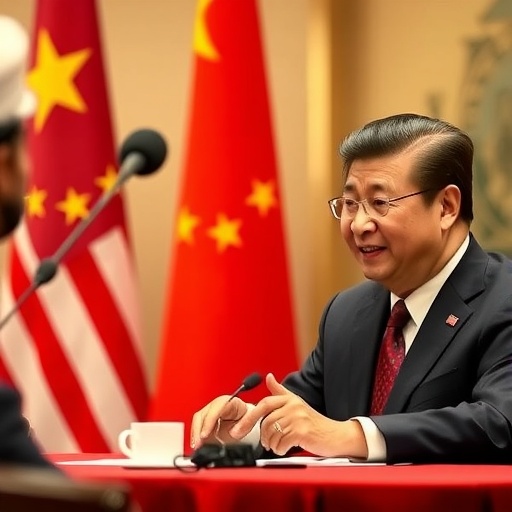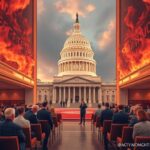US-China trade Talks Escalate in Malaysia: Rare Earth Export Bans Fuel Global Outrage Before Trump-Xi Summit
In a high-stakes diplomatic dance, Treasury Secretary Scott Bessent and Chinese Vice Premier He Lifeng convened urgent US-China trade discussions in Malaysia on Saturday, laying the groundwork for a pivotal Thursday summit between President Donald Trump and Chinese President Xi Jinping. The talks come amid escalating tensions over China’s aggressive rare earth exports restrictions, which have united the G7 nations, Europe, and Japan in a rare show of solidarity against Beijing’s resource dominance. With U.S. tariffs on Chinese goods potentially skyrocketing to 157% if no agreement is forged, the world watches as these Malaysia negotiations could redefine global supply chains and technological innovation.
- Malaysia Negotiations Unpack Layers of US-China trade Frictions
- China’s Rare Earth Export Controls Ignite Unified Global Backlash
- Escalating US Tariffs Threaten to Reshape Global Supply Chains
- G7, Europe, and Japan Forge Alliance Against Beijing’s Resource Grip
- Trump-Xi Summit Holds Keys to Averting Trade War Escalation
The rare earth exports saga, often dubbed the “new oil” of the 21st century, underscores the fragility of international trade. These 17 metallic elements are indispensable for everything from smartphone batteries to electric vehicle motors and military hardware. China’s near-monopoly—controlling over 80% of global production—has long been a point of contention, but recent export curbs imposed in response to U.S. tech restrictions have pushed the issue to a boiling point. Industry analysts warn that prolonged disruptions could add billions to manufacturing costs worldwide, stalling green energy transitions and defense capabilities.
“This is not just about trade; it’s about securing the future of innovation,” Bessent stated during a press briefing in Kuala Lumpur, emphasizing the U.S. resolve to diversify supply chains. On the Chinese side, He Lifeng echoed calls for mutual respect, but insiders reveal Beijing’s firm stance on protecting its strategic assets. As the Trump-Xi summit approaches, the pressure mounts for a breakthrough that could avert a full-blown trade war.
Malaysia Negotiations Unpack Layers of US-China trade Frictions
The Malaysia negotiations marked a strategic pivot, choosing neutral ground in Southeast Asia to foster dialogue away from the glare of Washington or Beijing. Held at a discreet resort in Langkawi, the two-day session focused on de-escalating tariffs and addressing rare earth exports bottlenecks. Sources close to the talks indicate that Bessent pushed for immediate relaxations in China’s export quotas, which were tightened last month following U.S. bans on advanced semiconductor sales to Chinese firms.
Historical context adds depth to these discussions. The U.S.-China trade war, reignited under Trump’s second term, has already imposed duties on over $500 billion in bilateral goods. According to the U.S. Trade Representative’s office, average tariffs stand at 19% on Chinese imports, but escalation clauses could triple that figure. China’s retaliatory measures, including a 25% hike on U.S. agricultural products, have squeezed American farmers, prompting $12 billion in federal aid last year alone.
During the Malaysia negotiations, both sides exchanged proposals on intellectual property protections and market access. A leaked memo from the Chinese delegation highlighted willingness to increase rare earth quotas by 15% if the U.S. lifts certain tech export controls. However, sticking points remain, particularly around enforcement mechanisms. “We’re not here to dictate terms, but to find common ground,” He Lifeng told reporters, signaling a pragmatic approach tempered by national interests.
Economists project that a successful outcome could boost global GDP by 0.5% through stabilized supply chains. Conversely, failure might trigger a 2-3% rise in electronics prices, hitting consumers from Tokyo to Toronto. The choice of Malaysia, a key player in the Regional Comprehensive Economic Partnership (RCEP), underscores the broader Asian pivot in US-China trade dynamics.
China’s Rare Earth Export Controls Ignite Unified Global Backlash
China’s decision to impose stringent rare earth exports controls has reverberated across continents, drawing sharp rebukes from the G7 summit in Hiroshima earlier this year. The restrictions, which limit shipments of neodymium and dysprosium—critical for wind turbines and missiles—were framed by Beijing as a defensive measure against Western “containment” policies. Yet, the move has backfired, galvanizing opposition from allies who fear weaponized resource scarcity.
The G7’s joint statement condemned the curbs as “disruptive to fair trade,” with leaders from Canada, France, Germany, Italy, Japan, the UK, and the U.S. vowing coordinated responses. Europe, heavily reliant on Chinese rare earths for its €1 trillion automotive sector, has seen stocks in companies like Volkswagen and Siemens dip 5-7% since the announcement. Japanese Prime Minister Fumio Kishida labeled the controls “economic coercion,” prompting Tokyo to accelerate domestic mining investments in Australia and Vietnam.
Statistics paint a stark picture: China supplied 63,000 metric tons of rare earth oxides in 2023, up from 58,000 the prior year, but export licenses have since plummeted by 40%. This squeeze has idled factories in South Korea’s battery industry, where LG Energy Solution reported a $200 million quarterly loss. U.S. defense contractors, including Lockheed Martin, have warned of delays in F-35 production, as rare earths comprise 10% of the jet’s components.
“Beijing’s playbook is clear: leverage what you control,” said Dr. Emily Chen, a trade expert at the Brookings Institution. “But this time, it’s uniting former rivals against a common threat.” In response, the EU is fast-tracking a €10 billion fund for alternative sourcing, while Japan eyes partnerships with Greenland’s untapped deposits.
Escalating US Tariffs Threaten to Reshape Global Supply Chains
As the Trump-Xi summit looms, the specter of 157% tariffs on Chinese imports hangs like a sword of Damocles over US-China trade. This figure, derived from stacking existing duties with proposed escalations under Section 301 of the Trade Act, targets electronics, machinery, and critical minerals. Trump, campaigning on an “America First” agenda, has repeatedly vowed to “decouple” from China, a stance that could add $1,000 to the average American household’s annual expenses, per Peterson Institute estimates.
The tariff blueprint includes 100% duties on electric vehicles, 50% on semiconductors, and phased increases on rare earth-dependent goods. China’s countermeasures could mirror this, with potential bans on U.S. soybeans and aircraft, sectors worth $30 billion annually. During the Malaysia negotiations, Bessent reportedly floated a “pause” on new tariffs in exchange for verifiable export commitments, but Chinese officials dismissed it as “unrealistic.”
Business leaders are sounding alarms. Apple CEO Tim Cook, whose supply chain is 90% China-based, urged restraint in a recent op-ed, noting that tariffs could erode U.S. competitiveness. Meanwhile, mining firms like MP Materials in California are ramping up production, aiming to capture 20% of the domestic market by 2025 with a $1.5 billion expansion.
Broader implications extend to inflation and jobs. A Moody’s Analytics report forecasts 500,000 U.S. manufacturing jobs at risk if tariffs spike, offset partially by 300,000 in reshoring. For China, export losses could shave 1.2% off GDP growth, exacerbating youth unemployment at 15%.
G7, Europe, and Japan Forge Alliance Against Beijing’s Resource Grip
The global backlash to China’s rare earth exports restrictions has crystallized into an unprecedented alliance, with the G7, Europe, and Japan pooling resources to challenge Beijing’s dominance. At the recent G7 trade ministers’ meeting in Osaka, participants pledged $50 billion toward diversified mining and recycling initiatives. Europe’s Critical Raw Materials Act, enacted last spring, mandates 10% domestic sourcing by 2030, funneling €5 billion into African and Latin American ventures.
Japan, scarred by 2010’s rare earth embargo, leads with a $2.2 billion strategy to secure supplies from Kazakhstan and India. “We cannot allow one nation to hold the world’s tech future hostage,” declared Trade Minister Yasutoshi Nishimura. Collaborative efforts include a joint R&D hub in Brussels, focusing on sustainable extraction methods to reduce environmental fallout from mining.
Quotes from key figures underscore the unity. German Chancellor Olaf Scholz warned, “Resource nationalism undermines the green deal we all champion.” U.S. Commerce Secretary Gina Raimondo added, “This is a wake-up call for strategic autonomy.” The alliance’s first tangible step: a unified tariff framework on Chinese rare earths, potentially effective by year’s end if talks falter.
Challenges persist, however. Recycling rates for rare earths hover at 1%, far below the 30% target, and new mines take 10-15 years to develop. Still, this coalition signals a paradigm shift, pressuring China to negotiate from a position of multilateral scrutiny rather than unilateral power.
Trump-Xi Summit Holds Keys to Averting Trade War Escalation
Looking ahead, the Trump-Xi summit in Geneva on Thursday represents a make-or-break moment for US-China trade. Agenda items span rare earth exports, tariffs, and cybersecurity, with aides hinting at a “grand bargain” involving phased de-escalations. Trump, known for his deal-making flair, has teased “something huge” on social media, while Xi’s team emphasizes “win-win cooperation.”
Potential outcomes range from a temporary truce—perhaps capping tariffs at 60% and boosting rare earth flows by 20%—to a deadlock that accelerates decoupling. Analysts at Goldman Sachs predict a 60% chance of partial agreement, citing mutual economic pains: U.S. inflation at 3.2% and China’s factory activity contracting for five months.
Beyond economics, geopolitical ripples loom. A deal could ease Indo-Pacific tensions, bolstering alliances like AUKUS. Failure might embolden hawks, with Congress eyeing a “Rare Earth Security Act” to subsidize $20 billion in U.S. production. For global markets, stability would calm volatility; the Dow Jones has swung 4% on trade news alone this quarter.
As negotiators wrap up in Malaysia, the world anticipates Thursday’s verdict. Success could herald a new era of managed competition; stalemate risks fracturing the $25 trillion bilateral trade behemoth. Stakeholders from Silicon Valley to Shanghai brace for impacts that will echo for decades, underscoring trade’s role as the artery of modern geopolitics.








